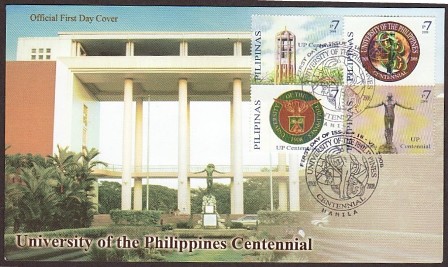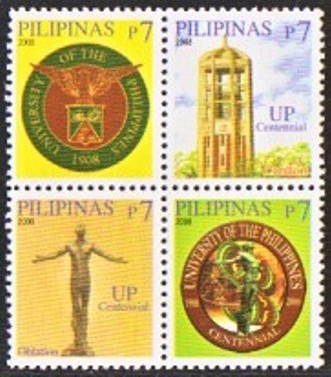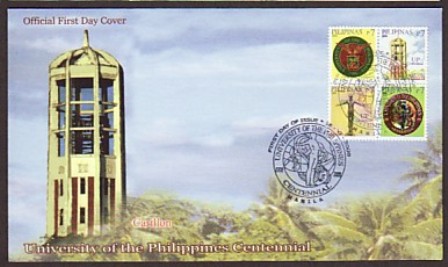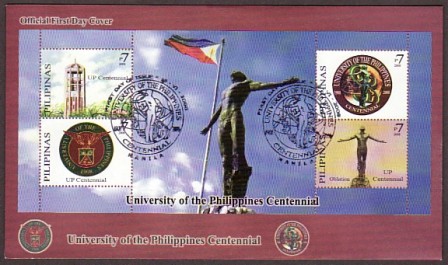2008, June 18. University of the Philippines Centennial
2008, July 7. (for the Sheetlet of 16 with foil stamping)
Litho Offset. Amstar Company, Inc. Perf. 14
Foil Stamping: Holotek Enterprises
Se-tenant Blocks of 4 (Large), Sheets of 40 (4 x 10)
Se-tenant Blocks of 4 (Small), Sheets of 100 (10 x 10)
Miniature Sheets of 16 with foil stamping (4 x 4)
Souvenir Sheets of 4 With and Without Foil Stamping

Se-tenant Blocks of Four - Large and Small Sizes
Souvenir Sheets: Issued Without foil stamping at P28 each; With foil stamping at P50 each
Se-tenant Blocks of Four (25,000) (Large)
7p UP Carillon by Juan Nakpil
7p UP Centennial Logo
7p UP Seal
7p UP Oblation by Guillermo Tolentino
Miniature Sheets of 16 with foil stamping (4,279)* (Priced at P160)
* Original quantity is 4,400 Miniature Sheets, less spoilage of 121 sheets
Se-tenant Blocks of Four (450,000) (Small)
7p UP Seal
7p UP Carillon by Juan Nakpil
7p UP Oblation by Guillermo Tolentino
7p UP Centennial Logo
28p Souvenir Sheets of Four
7p x 4 - Souvenir Sheet (6,000)
7p x 4 - Souvenir Sheet with foil stamping (6,874)* (Priced at P150)
* Original quantity is 7,000 Miniature Sheets less spoilage of 126
Graphic Designer: Corazon T. Loza
Design Coordinator: Dr. Ngo Tiong Tak
Layout Artists: Richard Allen Baron, Robinson C. Cruza
Artist : Alfred Rey B. Capiral, College of Fine Arts, UP Diliman
First Day Covers: Manila, and, U.P. Diliman, Quezon City

UNIVERSITY OF THE PHILIPPINES CENTENNIAL
The University of the Philippines (UP) is the country's premier university. It was established in 1908 by the American colonial government to provide quality education in philosophy, the sciences and the arts, as well as professional and technical training, to deserving students of all classes.
From a small campus in old Manila, with only 7 colleges, it has grown into a university system, with seven constituent universities located in 12 campuses throughout the Philippines.
To date, the University has produced 30 out of 31 National Scientists in fields as diverse as history, engineering, physics, agriculture, biophysical chemistry, psychology, medicine, plant physiology, genetics, and cytogenetics. In the age of technological breakthroughs, UP is at the forefront of exploring "emerging fields" in Science and Technology. The overarching goal is to identify high-priority, cutting-edge areas where the University can make a difference, such as Materials Biotechnology or Bioengineering, Pervasive Computing, and Measurement Instrumentation. The University's scientists are expected to break new ground in bio-fuels, pharmaceuticals, robust crops, new vaccines, cutting-edge microchips, early warning systems for disasters, energy efficient sensors and instruments, and nanoscales. These applications will have a significant effect on production in key sectors of the country.
UP Carillon by Juan Nakpil. The UP Carillon was donated to the University in 1952 with National Artist for Architecture Juan Nakpil designing the tower. The original Carillon had 48 bells and were forged by Van Bergen Co. The original Carillon had four octaves while the newly restored UP Carillon has only three octaves.
Juan F. Nakpil, architect, teacher and civic leader, is a pioneer and innovator in Philippine architecture. In essence, Nakpil's greatest contribution is his belief that there is such a thing as Philippine Architecture, espousing architecture reflective of Philippine traditions and culture. It is also largely due to his zealous representation and efforts that private Filipino architects and engineers, by law, are now able to participate in the design and execution of government projects.
He has integrated strength, function, and beauty in the buildings that are the country's heritage today. He designed the 1937 International Eucharistic Congress altar and rebuilt and enlarged the Quiapo Church in 1930 adding a dome and a second belfry to the original design.
Information taken from: The Philippine Builder -
http://www.philippine-builder.com/featured/people/architect/221-juan-f-nakpil.html
and, Reese Blog of Railways and Industrial Heritage Society of the Philippines
http://blog.rihspi.org/2007/12/university-of-philippines-carillon.html
UP Oblation by Guillermo Tolentino. No symbol is more closely identified with the University of the Philippines than the statue of the Oblation. The naked figure of a young man in a symbolic gesture of sacrificial offering of service to country and humanity has become a landmark in every campus of the University. For the hundreds of thousands of UP Alumni, the Oblation has become their major symbolic link with Alma Mater. The Oblation is also the major rallying point for all kinds of dissent, protest actions, and social criticism, as well as expressions of public service, nationalism, and patriotism. For the autonomous units and all the campuses of the University of the Philippines, the Oblation is the enduring symbol of their unity in mission, vision and traditions.
The Oblation, a masterpiece of Filipino sculptor Guillermo E. Tolentino, was commissioned in 1935 by President Rafael Palma, first Filipino president of the University. His order was for professor Tolentino to translate the second stanza of Rizal's "Last Farewell" into a monument which would be the identifying landmark of the University.
Information taken from: The University of the Philippines (UP) Alumni Association of Greater Chicago - http://upaagc.org/oblation.html
-
Schools & Universities
-
Art / Sculptures
-
Flags


